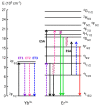Non-Linear Optical Properties of Er3+-Yb3+-Doped NaGdF4 Nanostructured Glass-Ceramics
- PMID: 32708192
- PMCID: PMC7408096
- DOI: 10.3390/nano10071425
Non-Linear Optical Properties of Er3+-Yb3+-Doped NaGdF4 Nanostructured Glass-Ceramics
Abstract
Transparent oxyfluoride glass-ceramics containing NaGdF4 nanocrystals were prepared by melt-quenching and doped with Er3+ (0.5 mol%) and different amounts of Yb3+ (0-2 mol%). The selected dopant concentration the crystallization thermal treatments were chosen to obtain the most efficient visible up-conversion emissions, together with near infrared emissions. The crystal size increased with dopant content and treatment time. NaGdF4 NCs with a size ranging 9-30 nm were obtained after heat treatments at Tg + 20-80 °C as confirmed by X-ray diffraction and high-resolution transmission electron microscopy. Energy dispersive X-ray analysis shows the incorporation of rare earth ions into the NaGdF4 nanocrystals. Near-infrared emission spectra, together with the up-conversion emissions were measured. The optical characterization of the glass-ceramics clearly shows that Er3+ and Yb3+ ions are incorporated in the crystalline phase. Moreover, visible up-conversion emissions could be tuned by controlling the nanocrystals size through appropriated heat treatment, making possible a correlation between structural and optical properties.
Keywords: crystallization; nonlinear optical properties; oxyfluoride glass–ceramic; rare-earth.
Conflict of interest statement
The authors declare no conflict of interest.
Figures









References
-
- Fedorov P.P., Luginina A.A., Popov A.I. Transparent oxyfluoride glass ceramics. J. Fluor. Chem. 2015;172:22–50. doi: 10.1016/j.jfluchem.2015.01.009. - DOI
-
- de Pablos-Martín A., Durán A., Pascual M.J. Nanocrystallisation in oxyfluoride systems: Mechanisms of crystallisation and photonic properties. Int. Mater. Rev. 2012;57:165–186. doi: 10.1179/1743280411Y.0000000004. - DOI
-
- Wang Y., Ohwaki J. New transparent vitroceramics codoped with Er3+ and Yb3+ for efficient frequency upconversion. Appl. Phys. Lett. 1993;63:3268–3270. doi: 10.1063/1.110170. - DOI
-
- Rodríguez V.D., Tikhomirov V.K., Méndez-Ramos J., Seddon A.B. The shape of the 1.55 μm emission band of the Er3+-dopant in oxyfluoride nano-scaled glass-ceramics. Europhys. Lett. 2005;69:128–134. doi: 10.1209/epl/i2004-10314-3. - DOI
Grants and funding
- PPG17/07/Basque Country University
- MAT2017-87035-C2-1-P/2-P/Ministerio de Economía, Industria y Competitividad, Gobierno de España
- grant agreement No 739566/Horizon 2020
- ITMS code 313011R453/operational program Research and innovation Slovak Republic, European Regional Development Fund
- PIBA2018-24/Basque Government
LinkOut - more resources
Full Text Sources
Miscellaneous

